|
FLK N I 914 |
1358 |
7 - FLK North |
|
L-MAN |
|
104 - Unknown |
I |
|
1, 2, 3 |
Gentry, A. W. 1966 Fossil Antilopini of East Africa. Bulletin of the British Museum of Natural History, Geology. 12: 43-106. 9 pls. |
|
137 - A. Gentry |
|
|
Yes |
|
Mammalia |
Artiodactyla |
Ruminantia |
|
Bovoidea |
Bovidae |
Antilopinae |
Antilopini |
Gazella |
wellsi |
|
|
No |
|
FLK N I 503 |
1360 |
7 - FLK North |
|
L-MAN |
|
104 - Unknown |
I |
|
1, 2, 3 |
Gentry, A. W. 1966 Fossil Antilopini of East Africa. Bulletin of the British Museum of Natural History, Geology. 12: 43-106. 9 pls. |
|
137 - A. Gentry |
|
|
Yes |
|
Mammalia |
Artiodactyla |
Ruminantia |
|
Bovoidea |
Bovidae |
Antilopinae |
Antilopini |
Gazella |
wellsi |
|
|
No |
|
M. 22451 |
1529 |
19 - SHK |
|
L-PVG |
1935 |
114 - Natural History Museum UK |
II |
|
|
Gentry, A. W. 1966 Fossil Antilopini of East Africa. Bulletin of the British Museum of Natural History, Geology. 12: 43-106. 9 pls. |
This is from a sub-adult. It is probably from the same individual as 22444. |
137 - A. Gentry |
|
264 - Leakey family expedition, 273 - Reck expedition |
Unknown |
|
Mammalia |
Artiodactyla |
Ruminantia |
|
Bovoidea |
Bovidae |
Antilopinae |
Neotragini |
Phenacotragus |
recki |
|
|
No |
|
M. 22391 |
1530 |
19 - SHK |
|
L-PVG |
1935 |
114 - Natural History Museum UK |
II |
|
|
Gentry, A. W. 1966 Fossil Antilopini of East Africa. Bulletin of the British Museum of Natural History, Geology. 12: 43-106. 9 pls. |
There are two left juvenile pelvic girdles labeled as M. 22391. |
137 - A. Gentry |
|
264 - Leakey family expedition, 273 - Reck expedition |
Unknown |
|
Mammalia |
Artiodactyla |
Ruminantia |
|
Bovoidea |
Bovidae |
Antilopinae |
Neotragini |
Phenacotragus |
recki |
|
|
No |
|
1911 VI 501 |
8592 |
|
|
L-M |
1911 |
116 - Bayerische Staatssammlung für Paläontologie und Geologie (BSPG), Munich, Germany |
|
|
|
Dietrich, W.O. 1937. Pleistoz |
M2. Reck Field No.: none. Originally described by Dietrich as part of 1911 VI 9. �Leakey, 1965 used the name Libytherium olduvaiensis. |
|
|
273 - Reck expedition |
Unknown |
|
Mammalia |
Artiodactyla |
Ruminantia |
|
Giraffoidea |
Giraffidae |
Sivatheriinae |
|
Sivatherium |
olduvaiensis |
|
Inventoried by Faysal Bibi in 2012. |
No |
|
1911 VI 9 |
8593 |
|
|
L-M |
1911 |
116 - Bayerische Staatssammlung für Paläontologie und Geologie (BSPG), Munich, Germany |
|
|
|
Dietrich, W.O. 1937. Pleistoz |
M1. Reck Field No.: none. 1911 VI 501 originally shared same number. |
|
|
273 - Reck expedition |
Unknown |
|
Mammalia |
Artiodactyla |
Ruminantia |
|
Giraffoidea |
Giraffidae |
Sivatheriinae |
|
Sivatherium |
olduvaiensis |
|
Inventoried by Faysal Bibi in 2012. |
No |
|
OVPP-Heterocephalus 6 |
2901 |
7 - FLK North |
|
SKULL-f, R/L-M |
|
104 - Unknown |
I |
upper |
|
Denys, C. 1989. A new species of bathyergid rodent from Olduvai Bed I (Tanzania, Lower Pleistocene). Neue Jahrbuecher Geologica Palaeontologica 5:257-264. |
This specimen is picture in figure 1-1 and 1-2. |
147 - C. Denys |
|
|
Yes |
|
Mammalia |
Rodentia |
|
|
|
Bathyergidae |
Heterocephalinae |
|
Heterocephalus |
jaegeri |
|
Holotype? |
No |
|
OVPP-Heterocephalus 3 |
2902 |
7 - FLK North |
|
SKULL-f, R/L-M |
|
104 - Unknown |
I |
upper |
|
Denys, C. 1989. A new species of bathyergid rodent from Olduvai Bed I (Tanzania, Lower Pleistocene). Neue Jahrbuecher Geologica Palaeontologica 5:257-264. |
This specimen is pictured in figure 1-3. |
147 - C. Denys |
|
|
Unknown |
|
Mammalia |
Rodentia |
|
|
|
Bathyergidae |
Heterocephalinae |
|
Heterocephalus |
jaegeri |
|
Hypodigm |
No |
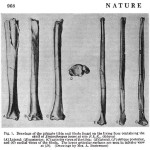 |
OH 6 |
3721 |
5 - FLK |
283 - 45 |
CRA-f
, M-f
, L-P
, L-TIB-f
, L-FIB-f
, |
1959/60 |
122 - National Museum and House of Culture, Dar es Salaam, Tanzania |
I |
Middle (Zinj.) |
Surface. Cranial and dental fragments found in surface soil from slope immediately below Zinj. site; assumed to be from Zinj. level (Leakey, MD, 1971:227). TIB-f and FIB-f from Zinj. level. |
Davis, P. R. 1964. Hominid fossils from Bed I, Olduvai Gorge, Tanganyika. A tibia and fibula. Nature. 201, 967. |
From Tobias (1991): OH 35 tibia and fibula attributed to same individual as OH 6 but appear to be more mature. It is unclear if OH 35 tibia and fibula are the same tibia and fibula originally listed under OH 6. Leakey, MD, 1971 describes CRA and dental fragments as having been found in surface soil, but Leakey, Tobias, and Napier, 1964 state "some [were] found in situ [and] some on the surface" (:9). Unworn lower L-P3. Partially developed roots of upper M1 or 2. Six cranial vault fragments. Tibia and fibula fragments first assumed to be associated with Zinjanthropus OH5, but should be considered associates with OH 6 following morphological study (Leakey, MD, 1971:227). and skull fragments. Juvenile. Specimen previously housed at National Museum of Kenya. |
|
|
264 - Leakey family expedition |
Unknown |
|
Mammalia |
Primates |
Anthropoidea |
Haplorhini |
Hominoidea |
Hominidae |
Homininae |
Hominini |
Homo |
habilis |
|
Paratype. TIB-f and FIB-f not given taxonomic designation in original publication (Davis, 1964) but named as a paratype in Leakey, Tobias, and Napier, 1964. |
No |
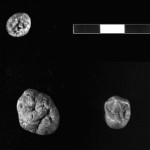 |
OH 73 |
3788 |
81 - HWK W |
|
L-P |
2006 |
127 - National Natural History Museum, Arusha, Tanzania |
I |
Upper |
Surface. |
Clarke, R.J. Published online 4 May 2012. A Homo habilis maxilla and other newly-discovered hominid fossils from Olduvai Gorge, Tanzania.� Olduvai Special issue, JHE |
Left P3.�Specimen is pictured third from the left bottom in image 1.�Specimen is shown on left in image 2. |
|
|
|
No |
|
Mammalia |
Primates |
Anthropoidea |
Haplorhini |
Hominoidea |
Hominidae |
Homininae |
Hominini |
Homo |
habilis |
sensu stricto |
|
No |
|
OVPP-Soricidae 1 |
3851 |
7 - FLK North |
|
L-MAN |
|
|
I |
2 |
|
Butler, P., and Greenwood, M. 1979. Soricidae (Mammalia) from the Early Pleistocene of Olduvai Gorge, Tanzania. Zoological Journal of the Linnean Society 67:329-379. |
Authors describe specimen as "left mandibular ramus with P4-M2 moderately worn, and with the roots of I1, I2, and M3. |
150 - Butler and Greenwood |
|
|
Unknown |
|
Mammalia |
Insectivora |
|
|
Soricoidea |
Soricidae |
|
|
|
|
|
One of five specimens of indeterminant species of Soricidae from Olduvai. Authors state that there appears to be three different species represented in the indeterminant specimens. This specimen is described as Species I. |
No |
|
OVPP-Soricidae 2 |
3852 |
7 - FLK North |
|
L-MAN, (n=3) |
|
|
I |
5 |
|
Butler, P., and Greenwood, M. 1979. Soricidae (Mammalia) from the Early Pleistocene of Olduvai Gorge, Tanzania. Zoological Journal of the Linnean Society 67:329-379. |
Three left mandibular fragments. |
150 - Butler and Greenwood |
|
|
Unknown |
|
Mammalia |
Insectivora |
|
|
Soricoidea |
Soricidae |
|
|
|
|
|
Three of five specimens of indeterminant species of Soricidae from Olduvai. Authors state that there appears to be three different species represented in the indeterminant specimens. These specimens are described as Species II. |
No |
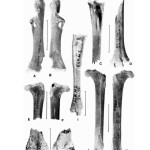 |
OLD 15802 |
10155 |
|
|
L-COR |
|
|
I |
|
Layer 3 |
Brodkorb P., Mourer-Chauviré, C. 1984. Fossil owls from early man sites of Olduvai Gorge, Tanzania. Ostrich; Journal of African Ornithology 55:17-27. |
HOLOTYPE. "Left coracoid lacking the procoracoid and the external distal angle... Paratypes: The following specimens are from layer 3 of locality FLK NNI and can be attributed to the same individual as the holotype: 15740, premaxillae; 3301, lower part of right coracoid. 15364 and 15473, proximal and distal parts of left femur; 16377, distal part of right femur; 15701, distal part of left tibiotarsus; 15776, left fibula; 16262, proximal part of right tarsometatarsus; 15730, distal part of left tarsometatarsus; 15942, 15946, 16050, 16171, 16174, 16176 to 16180, pedal phalanges. Place of conservation of the material: The fossils are currently on deposit at the University of Florida, Department of Zoology, and will later be returned to Tanzania" (Brodkorb and Mourer-Chauvire, 1984:17, 19). Image notes: (Scale = 2 cm) A-B: Left coracoid, holotype, OLD 15802, FLK NNI, layer 3, A anterior face, B posterior face. C: Right tarsometatarsus, proximal part, paratype, OLD 16262, FLK NNI, scree, anterior face. D: Left tarsometatarsus, distal part, paratype, OLD 15730, FLK NNI, layer 3, anterior face. E-F: Left femur, proximal half, paratype, OLD 15364, FLK NNI, layer 2+3, E anterior face, F POSterior face. G-H: Left femur, distal part, paratype, OLD 15473, FLK NNI, layer 3, G anterior face, H posterior face. I: Left tarsometatarsus, almost complete, OLD 11574, FLK NI, layer 1, anterior face. J-K: Left femur, lacking the distal part, OLD 11586, FLK NI, layer 2, J anterior face, K posterior face. |
|
|
|
Unknown |
|
Aves |
Strigiformes |
|
|
|
Strigidae |
|
|
Bubo |
leakeyae |
|
|
No |
 |
OLD 15473 |
10158 |
6 - FLK NN |
|
L-FEM |
|
|
I |
|
Layer 3 |
Brodkorb P., Mourer-Chauviré, C. 1984. Fossil owls from early man sites of Olduvai Gorge, Tanzania. Ostrich; Journal of African Ornithology 55:17-27. |
PARATYPE. OLD 15364 and OLD 15473 are "proximal and distal parts of left femur" (Brodkorb and Mourer-Chauvire, 1984:17). "Paratypes: The following specimens are from layer 3 of locality FLK NNI and can be attributed to the same individual as the holotype: 15740, premaxillae; 3301, lower part of right coracoid. 15364 and 15473, proximal and distal parts of left femur; 16377, distal part of right femur; 15701, distal part of left tibiotarsus; 15776, left fibula; 16262, proximal part of right tarsometatarsus; 15730, distal part of left tarsometatarsus; 15942, 15946, 16050, 16171, 16174, 16176 to 16180, pedal phalanges. Place of conservation of the material: The fossils are currently on deposit at the University of Florida, Department of Zoology, and will later be returned to Tanzania" (Brodkorb and Mourer-Chauvire, 1984:17, 19). Image notes: (Scale = 2 cm) A-B: Left coracoid, holotype, OLD 15802, FLK NNI, layer 3, A anterior face, B posterior face. C: Right tarsometatarsus, proximal part, paratype, OLD 16262, FLK NNI, scree, anterior face. D: Left tarsometatarsus, distal part, paratype, OLD 15730, FLK NNI, layer 3, anterior face. E-F: Left femur, proximal half, paratype, OLD 15364, FLK NNI, layer 2+3, E anterior face, F Posterior face. G-H: Left femur, distal part, paratype, OLD 15473, FLK NNI, layer 3, G anterior face, H posterior face. I: Left tarsometatarsus, almost complete, OLD 11574, FLK NI, layer 1, anterior face. J-K: Left femur, lacking the distal part, OLD 11586, FLK NI, layer 2, J anterior face, K posterior face. |
|
|
|
Unknown |
|
Aves |
Strigiformes |
|
|
|
Strigidae |
|
|
Bubo |
leakeyae |
|
|
No |
 |
OLD 15701 |
10161 |
6 - FLK NN |
|
L-TBT-f |
|
|
I |
|
Layer 3 scree |
Brodkorb P., Mourer-Chauviré, C. 1984. Fossil owls from early man sites of Olduvai Gorge, Tanzania. Ostrich; Journal of African Ornithology 55:17-27. |
PARATYPE. Distal portion of left tibiotarsus. "Paratypes: The following specimens are from layer 3 of locality FLK NNI and can be attributed to the same individual as the holotype: 15740, premaxillae; 3301, lower part of right coracoid. 15364 and 15473, proximal and distal parts of left femur; 16377, distal part of right femur; 15701, distal part of left tibiotarsus; 15776, left fibula; 16262, proximal part of right tarsometatarsus; 15730, distal part of left tarsometatarsus; 15942, 15946, 16050, 16171, 16174, 16176 to 16180, pedal phalanges. Place of conservation of the material: The fossils are currently on deposit at the University of Florida, Department of Zoology, and will later be returned to Tanzania" (Brodkorb and Mourer-Chauvire, 1984:17, 19). Image notes: (Scale = 2 cm) A-B: Left coracoid, holotype, OLD 15802, FLK NNI, layer 3, A anterior face, B posterior face. C: Right tarsometatarsus, proximal part, paratype, OLD 16262, FLK NNI, scree, anterior face. D: Left tarsometatarsus, distal part, paratype, OLD 15730, FLK NNI, layer 3, anterior face. E-F: Left femur, proximal half, paratype, OLD 15364, FLK NNI, layer 2+3, E anterior face, F Posterior face. G-H: Left femur, distal part, paratype, OLD 15473, FLK NNI, layer 3, G anterior face, H posterior face. I: Left tarsometatarsus, almost complete, OLD 11574, FLK NI, layer 1, anterior face. J-K: Left femur, lacking the distal part, OLD 11586, FLK NI, layer 2, J anterior face, K posterior face. |
|
|
|
Unknown |
|
Aves |
Strigiformes |
|
|
|
Strigidae |
|
|
Bubo |
leakeyae |
|
|
No |
 |
OLD 15776 |
10162 |
6 - FLK NN |
|
L-FIB |
|
|
I |
|
Layer 3 scree |
Brodkorb P., Mourer-Chauviré, C. 1984. Fossil owls from early man sites of Olduvai Gorge, Tanzania. Ostrich; Journal of African Ornithology 55:17-27. |
PARATYPE. "Paratypes: The following specimens are from layer 3 of locality FLK NNI and can be attributed to the same individual as the holotype: 15740, premaxillae; 3301, lower part of right coracoid. 15364 and 15473, proximal and distal parts of left femur; 16377, distal part of right femur; 15701, distal part of left tibiotarsus; 15776, left fibula; 16262, proximal part of right tarsometatarsus; 15730, distal part of left tarsometatarsus; 15942, 15946, 16050, 16171, 16174, 16176 to 16180, pedal phalanges. Place of conservation of the material: The fossils are currently on deposit at the University of Florida, Department of Zoology, and will later be returned to Tanzania" (Brodkorb and Mourer-Chauvire, 1984:17, 19). Image notes: (Scale = 2 cm) A-B: Left coracoid, holotype, OLD 15802, FLK NNI, layer 3, A anterior face, B posterior face. C: Right tarsometatarsus, proximal part, paratype, OLD 16262, FLK NNI, scree, anterior face. D: Left tarsometatarsus, distal part, paratype, OLD 15730, FLK NNI, layer 3, anterior face. E-F: Left femur, proximal half, paratype, OLD 15364, FLK NNI, layer 2+3, E anterior face, F Posterior face. G-H: Left femur, distal part, paratype, OLD 15473, FLK NNI, layer 3, G anterior face, H posterior face. I: Left tarsometatarsus, almost complete, OLD 11574, FLK NI, layer 1, anterior face. J-K: Left femur, lacking the distal part, OLD 11586, FLK NI, layer 2, J anterior face, K posterior face. |
|
|
|
Unknown |
|
Aves |
Strigiformes |
|
|
|
Strigidae |
|
|
Bubo |
leakeyae |
|
|
No |
 |
OLD 15730 |
10163 |
6 - FLK NN |
|
L-TARMET-f |
|
|
I |
|
Layer 3 scree |
Brodkorb P., Mourer-Chauviré, C. 1984. Fossil owls from early man sites of Olduvai Gorge, Tanzania. Ostrich; Journal of African Ornithology 55:17-27. |
PARATYPE. Distal portion of left tarsometatarsus. "Paratypes: The following specimens are from layer 3 of locality FLK NNI and can be attributed to the same individual as the holotype: 15740, premaxillae; 3301, lower part of right coracoid. 15364 and 15473, proximal and distal parts of left femur; 16377, distal part of right femur; 15701, distal part of left tibiotarsus; 15776, left fibula; 16262, proximal part of right tarsometatarsus; 15730, distal part of left tarsometatarsus; 15942, 15946, 16050, 16171, 16174, 16176 to 16180, pedal phalanges. Place of conservation of the material: The fossils are currently on deposit at the University of Florida, Department of Zoology, and will later be returned to Tanzania" (Brodkorb and Mourer-Chauvire, 1984:17, 19). Image notes: (Scale = 2 cm) A-B: Left coracoid, holotype, OLD 15802, FLK NNI, layer 3, A anterior face, B posterior face. C: Right tarsometatarsus, proximal part, paratype, OLD 16262, FLK NNI, scree, anterior face. D: Left tarsometatarsus, distal part, paratype, OLD 15730, FLK NNI, layer 3, anterior face. E-F: Left femur, proximal half, paratype, OLD 15364, FLK NNI, layer 2+3, E anterior face, F Posterior face. G-H: Left femur, distal part, paratype, OLD 15473, FLK NNI, layer 3, G anterior face, H posterior face. I: Left tarsometatarsus, almost complete, OLD 11574, FLK NI, layer 1, anterior face. J-K: Left femur, lacking the distal part, OLD 11586, FLK NI, layer 2, J anterior face, K posterior face. |
|
|
|
Unknown |
|
Aves |
Strigiformes |
|
|
|
Strigidae |
|
|
Bubo |
leakeyae |
|
|
No |
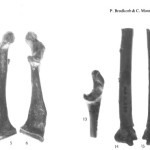 |
11 234 |
10182 |
58 - KK |
|
L-ULNA-f |
|
|
II |
"Probably lower middle" (Brodkorb and Mourer-Chauvire, 1982:510). |
|
Brodkorb P., Mourer-Chauviré C. 1982. Fossil Anhingas (Aves: Anhingidae) from early man sites of Hadar and Omo (Ethiopia) and Olduvai Gorge (Tanzania). Geobios 15: 505-515 |
Distal half of left ulna. "Place of conservation of material : The fossils are currently on deposit at the University of Florida, Department of Zoology, and will later be returned to their countries of origin. The serial numbers such as 2780 are catalogue numbers of the Olduvai birds, and the data are kept at the University of Florida, Gainesville" (Brodkorb and Mourer-Chauvire, 1982:510). Figure description: "Fig. 14 - 15 -- Distal half of left ulna, 11 234, Lower Pleistocene, Kudu Korongo, Olduvai Gorge, Tanzania. (14) internal view. (15) external view." (Brodkorb and Mourer-Chauvire, 1982). |
|
|
264 - Leakey family expedition |
Unknown |
|
Aves |
Suliformes |
|
|
|
Anhingidae |
|
|
Anhinga |
hadarensis |
|
|
No |
|
F4636 |
3067 |
24 - DK |
|
SHEL-f |
|
105 - National Museum and House of Culture, Dar es Salaam, Tanzania (?) |
I |
|
|
Auffenberg, W. 1981. The fossil turtles of Olduvai Gorge, Tanzania, Africa. Copeia 1981:509-522. |
Original information indicated that this specimen was located in Nairobi. This specimen is likely within the material that was repatriated to Dar in 2011, but this has yet to be confirmed. |
152 - W. Auffenberg |
|
264 - Leakey family expedition |
Unknown |
|
Reptilia |
Testudines |
|
|
|
|
|
|
|
|
|
The author mentions there are over 3,000 fossilized turtle fragments from Olduvai Gorge, 98% of which are from the species Pelusios sinuatus. However, it is unclear which specimens belong to which species based on the description given. When it was unclear, the specimen is only referred to as belonging to the Order Testudines. |
No |
|
OVPP-Geochelone 1 |
3106 |
10 - BK |
|
R-HYPL-f |
|
105 - National Museum and House of Culture, Dar es Salaam, Tanzania (?) |
II |
|
|
Auffenberg, W. 1981. The fossil turtles of Olduvai Gorge, Tanzania, Africa. Copeia 1981:509-522. |
Original information indicated that this specimen was located in Nairobi. This specimen is likely within the material that was repatriated to Dar in 2011, but this has yet to be confirmed. |
152 - W. Auffenberg |
|
264 - Leakey family expedition |
Unknown |
|
Reptilia |
Testudines |
Cryptodira |
|
Testidinoidea |
Testudinidae |
|
|
Geochelone |
pardalis |
|
|
No |
|
OVPP-Geochelone 4 |
3109 |
24 - DK |
|
NRL-f |
|
105 - National Museum and House of Culture, Dar es Salaam, Tanzania (?) |
I |
|
|
Auffenberg, W. 1981. The fossil turtles of Olduvai Gorge, Tanzania, Africa. Copeia 1981:509-522. |
Original information indicated that this specimen was located in Nairobi. This specimen is likely within the material that was repatriated to Dar in 2011, but this has yet to be confirmed. |
152 - W. Auffenberg |
|
264 - Leakey family expedition |
Unknown |
|
Reptilia |
Testudines |
Cryptodira |
|
Testidinoidea |
Testudinidae |
|
|
Geochelone |
pardalis |
|
The author mentions there are over 3,000 fossilized turtle fragments from Olduvai Gorge, 98% of which are from the species Pelusios sinuatus. However, it is unclear which specimens belong to which species based on the description given. When it was unclear, the specimen is only referred to as belonging to the Order Testudines. |
No |
|
F558 |
3081 |
|
|
CARA-f, NRL-f |
|
106 - Natural History Museum UK (?) |
|
|
|
-- |
The authors say this specimen comes from "SI" though this is not a known locality. |
152 - W. Auffenberg |
|
|
Unknown |
|
Reptilia |
Testudines |
Cryptodira |
|
Testidinoidea |
Testudinidae |
|
|
Geochelone |
sp. |
|
The author puts this specimen in Geochelone, species B. |
No |
|
OVPP-Testudines 15 |
3086 |
18 - VEK |
|
SHEL-f |
|
106 - Natural History Museum UK (?) |
|
|
|
-- |
|
152 - W. Auffenberg |
|
|
Unknown |
|
Reptilia |
Testudines |
|
|
|
|
|
|
|
|
|
The author mentions there are over 3,000 fossilized turtle fragments from Olduvai Gorge, 98% of which are from the species Pelusios sinuatus. However, it is unclear which specimens belong to which species based on the description given. When it was unclear, the specimen is only referred to as belonging to the Order Testudines. |
No |
|
OVPP-Testudines 16 |
3087 |
70 - EHK |
|
SHEL-f |
|
106 - Natural History Museum UK (?) |
I |
|
|
-- |
|
152 - W. Auffenberg |
|
|
Unknown |
|
Reptilia |
Testudines |
|
|
|
|
|
|
|
|
|
The author mentions there are over 3,000 fossilized turtle fragments from Olduvai Gorge, 98% of which are from the species Pelusios sinuatus. However, it is unclear which specimens belong to which species based on the description given. When it was unclear, the specimen is only referred to as belonging to the Order Testudines. |
No |
|
OVPP-Testudines 17 |
3088 |
9 - THC |
|
SHEL-f |
|
106 - Natural History Museum UK (?) |
I |
|
|
-- |
|
152 - W. Auffenberg |
|
|
Unknown |
|
Reptilia |
Testudines |
|
|
|
|
|
|
|
|
|
The author mentions there are over 3,000 fossilized turtle fragments from Olduvai Gorge, 98% of which are from the species Pelusios sinuatus. However, it is unclear which specimens belong to which species based on the description given. When it was unclear, the specimen is only referred to as belonging to the Order Testudines. |
No |
|
F128 |
3089 |
19 - SHK |
|
SHEL-f |
|
105 - National Museum and House of Culture, Dar es Salaam, Tanzania (?) |
|
|
|
-- |
Original information indicated that this specimen was located in Nairobi. This specimen is likely within the material that was repatriated to Dar in 2011, but this has yet to be confirmed. |
152 - W. Auffenberg |
|
264 - Leakey family expedition |
Unknown |
|
Reptilia |
Testudines |
|
|
|
|
|
|
|
|
|
The author mentions there are over 3,000 fossilized turtle fragments from Olduvai Gorge, 98% of which are from the species Pelusios sinuatus. However, it is unclear which specimens belong to which species based on the description given. When it was unclear, the specimen is only referred to as belonging to the Order Testudines. |
No |
|
F240 |
3090 |
19 - SHK |
|
SHEL-f |
|
105 - National Museum and House of Culture, Dar es Salaam, Tanzania (?) |
|
|
|
-- |
Original information indicated that this specimen was located in Nairobi. This specimen is likely within the material that was repatriated to Dar in 2011, but this has yet to be confirmed. |
152 - W. Auffenberg |
|
264 - Leakey family expedition |
Unknown |
|
Reptilia |
Testudines |
|
|
|
|
|
|
|
|
|
The author mentions there are over 3,000 fossilized turtle fragments from Olduvai Gorge, 98% of which are from the species Pelusios sinuatus. However, it is unclear which specimens belong to which species based on the description given. When it was unclear, the specimen is only referred to as belonging to the Order Testudines. |
No |
|
OVPP-Testudines 18 |
3095 |
22 - SC |
|
SHEL-f |
|
106 - Natural History Museum UK (?) |
II |
|
|
-- |
|
152 - W. Auffenberg |
|
|
Unknown |
|
Reptilia |
Testudines |
|
|
|
|
|
|
|
|
|
The author mentions there are over 3,000 fossilized turtle fragments from Olduvai Gorge, 98% of which are from the species Pelusios sinuatus. However, it is unclear which specimens belong to which species based on the description given. When it was unclear, the specimen is only referred to as belonging to the Order Testudines. |
No |
|
F556 |
3101 |
8 - MK |
|
SHEL-f |
|
106 - Natural History Museum UK (?) |
IV |
|
|
-- |
|
152 - W. Auffenberg |
|
|
Unknown |
|
Reptilia |
Testudines |
|
|
|
|
|
|
|
|
|
The author mentions there are over 3,000 fossilized turtle fragments from Olduvai Gorge, 98% of which are from the species Pelusios sinuatus. However, it is unclear which specimens belong to which species based on the description given. When it was unclear, the specimen is only referred to as belonging to the Order Testudines. |
No |
|
F565 |
3102 |
8 - MK |
|
SHEL-f |
|
106 - Natural History Museum UK (?) |
IV |
|
|
-- |
|
152 - W. Auffenberg |
|
|
Unknown |
|
Reptilia |
Testudines |
|
|
|
|
|
|
|
|
|
The author mentions there are over 3,000 fossilized turtle fragments from Olduvai Gorge, 98% of which are from the species Pelusios sinuatus. However, it is unclear which specimens belong to which species based on the description given. When it was unclear, the specimen is only referred to as belonging to the Order Testudines. |
No |
|
F57 |
3103 |
8 - MK |
|
SHEL-f |
|
106 - Natural History Museum UK (?) |
IV |
|
|
-- |
|
152 - W. Auffenberg |
|
|
Unknown |
|
Reptilia |
Testudines |
|
|
|
|
|
|
|
|
|
The author mentions there are over 3,000 fossilized turtle fragments from Olduvai Gorge, 98% of which are from the species Pelusios sinuatus. However, it is unclear which specimens belong to which species based on the description given. When it was unclear, the specimen is only referred to as belonging to the Order Testudines. |
No |
|
F645 |
3104 |
8 - MK |
|
SHEL-f |
|
106 - Natural History Museum UK (?) |
IV |
|
|
-- |
|
152 - W. Auffenberg |
|
|
Unknown |
|
Reptilia |
Testudines |
|
|
|
|
|
|
|
|
|
The author mentions there are over 3,000 fossilized turtle fragments from Olduvai Gorge, 98% of which are from the species Pelusios sinuatus. However, it is unclear which specimens belong to which species based on the description given. When it was unclear, the specimen is only referred to as belonging to the Order Testudines. |
No |
|
F6647 |
3105 |
8 - MK |
|
SHEL-f |
|
106 - Natural History Museum UK (?) |
IV |
|
|
-- |
|
152 - W. Auffenberg |
|
|
Unknown |
|
Reptilia |
Testudines |
|
|
|
|
|
|
|
|
|
The author mentions there are over 3,000 fossilized turtle fragments from Olduvai Gorge, 98% of which are from the species Pelusios sinuatus. However, it is unclear which specimens belong to which species based on the description given. When it was unclear, the specimen is only referred to as belonging to the Order Testudines. |
No |
|
OVPP-Latisternon 1 |
3114 |
24 - DK |
|
L-EPLS |
|
105 - National Museum and House of Culture, Dar es Salaam, Tanzania (?) |
II |
|
|
-- |
The authors mention "thousands" of fragments and a few complete shells of this species found at Olduvai. Original information indicated that this specimen was located in Nairobi. This specimen is likely within the material that was repatriated to Dar in 2011, but this has yet to be confirmed. |
152 - W. Auffenberg |
|
264 - Leakey family expedition |
Unknown |
|
Reptilia |
Testudines |
|
|
|
Pelomedusidae |
|
|
Latisternon |
microsulcae |
|
Holotype |
No |
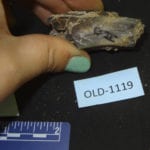 |
M 104144 |
13033 |
|
|
L-M |
|
114 - Natural History Museum UK |
II |
|
|
-- |
OLD-1119; left upper M1 or M2; (Last edit SC 2019) |
|
|
|
Unknown |
|
Mammalia |
Artiodactyla |
Ruminantia |
|
Bovoidea |
Bovidae |
Alcelaphinae |
Alcelaphini |
|
|
|
|
No |
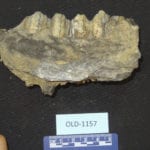 |
M 104153 |
13073 |
10 - BK |
|
L-MAN, M (3) |
|
114 - Natural History Museum UK |
II |
|
|
-- |
OLD-1157; L-MAN with M1-M3; "OLD BK II 9.V.35" |
|
|
|
Unknown |
|
Mammalia |
Artiodactyla |
Ruminantia |
|
Bovoidea |
Bovidae |
Alcelaphinae |
Alcelaphini |
|
|
|
|
No |
|
M 104154 |
13072 |
|
|
L-MAN-f |
|
114 - Natural History Museum UK |
|
|
|
-- |
OLD-1156 |
|
|
|
Unknown |
|
Mammalia |
Artiodactyla |
Ruminantia |
|
Bovoidea |
Bovidae |
Alcelaphinae |
Alcelaphini |
|
|
|
|
Unknown |
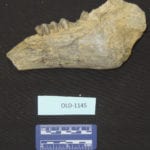 |
M 104157 |
13059 |
|
|
L-MAN, dP, M (2) |
|
114 - Natural History Museum UK |
|
|
|
-- |
OLD-1145; L-MAN with dP4-M2 |
|
|
|
Unknown |
|
Mammalia |
Artiodactyla |
Ruminantia |
|
Bovoidea |
Bovidae |
Alcelaphinae |
Alcelaphini |
|
|
|
|
No |
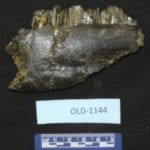 |
M 104151 |
13058 |
10 - BK |
|
L-MAN, P, M (2) |
|
114 - Natural History Museum UK |
II |
|
|
-- |
OLD-1144; L-MAN with P4-M2; "OLD Y BK II 9.V.35" |
|
|
|
Unknown |
|
Mammalia |
Artiodactyla |
Ruminantia |
|
Bovoidea |
Bovidae |
Alcelaphinae |
Alcelaphini |
|
|
|
|
No |
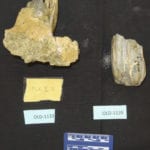 |
M 104163 |
13047 |
|
|
L-MAX-f, M |
|
114 - Natural History Museum UK |
|
|
|
-- |
OLD-1133; L-MAX-f with M3 |
|
|
|
Unknown |
|
Mammalia |
Artiodactyla |
Ruminantia |
|
Bovoidea |
Bovidae |
Alcelaphinae |
Alcelaphini |
|
|
|
|
No |












